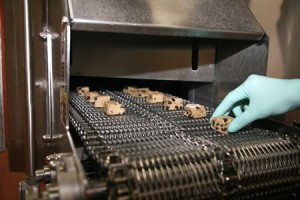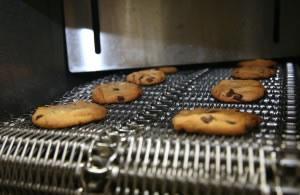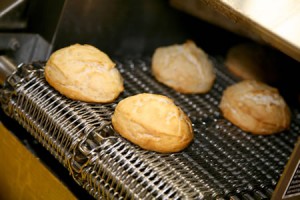High-Performance, Continuous Baking Ovens Provide Diverse Opportunities for Processors of All Sizes
Continuous cooking with advanced equipment offers smaller and medium-size bakers consistency of quality plus increased efficiency all in a small footprint.
A number of diverse factors, ranging from continued consolidation of large players to the introduction of advanced processing technologies are creating new opportunities for growth among the smaller and intermediate manufacturers of bakery products today.
One of the most significant opportunities could be for those processors to convert their operations from the more traditional batch baking of formed, pan, grilled, and en croûte products, to more efficient, high-performance continuous baking processes.
Whether producing items such as pies, pizza bases, artisan breads, pastries, desserts or appetizers, smaller baking operations today have unprecedented access to advanced, flexible cooking equipment that can make their businesses more productive in energy- and labor-efficiency, with improved consistency of quality and reduced product waste.
This includes a variety of continuous cooking equipment that can incorporate an assortment of technologies and parameters that can be tailored to suit processors’ needs: high-temperature cooking, impingement, double impingement, convection, super-heated vapor, integrated cooling, and linear or spiral cooking. This equipment can provide faster bake times, more uniform color, quicker product throughput and even a smaller equipment footprint – all with a relatively quick investment payback.
Batch vs. continuous
“The major advantage of the continuous process over the batch process is consistency in your operation,” says Jim Kline, president of The EnSol Group (Erwinna, PA). EnSol provides the baking and snack food industries with process and facility design and engineering as well as manufacturing support services and a variety of consulting services.
Kline, formerly Director of Engineering for Best Foods and George Weston, says that within each of the basic baking steps – in dough makeup, proofing, and then baking – whenever the process is started or stopped, a yield variance occurs.
“When you first get the dough started, and then as the dough tails off, it is simply the nature of the equipment that gives you inconsistency,” he explains. “So, the more continuously you run the process, the more consistent your food products will be. Also, the more consistent your process the more efficient your operation is in terms yield from the process and also labor utilization.”
Kline adds that the baking industry has seen consolidation of large players in the industry in recent years, and that their market segment is being well served. Yet there is some strong growth among the smaller and intermediate-size bakeries.
“For them to have the right equipment, including that which enables continuous processing, can be highly beneficial,” Kline says.
Additional performance improvements in continuous baking include energy savings of up to 15 percent when equipment is updated from outdated linear convection ovens.
“With batch ovens you are opening and closing the oven doors all the time, and then have to wait for the temperature to regain the required level,” says Adam Cowherd, vice president of sales with Unitherm Food Systems (Bristow, OK). “With the continuous-baking ovens, once the oven reaches the desired temperature, they will continue to hold that temperature for as long as you like.”
Although his company makes a wide variety of cooking equipment, Cowherd notes that members of the bakery industry are becoming increasingly interested in the benefits of continuous baking with newer oven designs such as Unitherm’s various sizes of spiral ovens.
“The design of these high-performance ovens are giving medium-size and small processors access to flexible, efficient, continuous baking equipment,” he explains. “For the larger processors, who may have been baking continuously all along, spiral ovens are helping them to recover footprint by replacing their traditional linear ovens.”
J. Roy Escoubas, Ph.D., is director at Oklahoma State University’s Robert M. Kerr Food & Agricultural Products Center in Stillwater, OK. This research laboratory has the food science capability to perform third-party tests on various food recipes and cooking equipment. His staff has performed a variety of preliminary tests using a spiral oven (manufactured by Unitherm) to determine the suitability of this type of continuous oven for baking a variety of products.
“We have not had the opportunity to make direct comparisons with the traditional batch ovens to see how they would compare with the spiral style for continuous baking,” Escoubas explains. “However, once we were able to establish the various parameters that are involved in controlling the cooking system (e.g. the belt speed, humidity, temperature profiles) we found that the spiral oven delivers consistent products such as very nice, traditional-looking, browned biscuits and cookies with a really wonderful texture that would compare well with anything you’re likely to find on the market. We found that we were able to produce those baked goods with the same quality characteristics time and time again. That’s the beauty of a continuous oven. Plus, the small footprint on a spiral oven adds additional value for end users.”
Eliminating the speed bumps
“Compared with a continuous process, a batch baking process seems like a speed bump that slows down the processing line,” Cowherd says. That is because many processors have automated the front ends of their systems, and have certainly automated back-end processes like packaging. That makes batch baking a restriction in the process flow.”
In addition to automating the cooking process, advanced continuous baking equipment is helping to improve on the efficiencies of steps in the process before and after cooking. For example, Unitherm is introducing a solution for integrating baking in molds in its spiral ovens. This allows our customers to obtain a reduced footprint by baking vertically through “captive trays” with continuous equipment.
As another example, using Unitherm’s double impinging spiral oven, processors can reduce the bake time on a fruit filled pie from 60 minutes to 35 minutes. In addition, using an inline spiral chiller, the cooling time of baked pies or other items can also be significantly reduced.
Cowherd points out that his firm has considerable experience with processors in the UK, where the baking industry is large and highly developed. He says that some of these companies are visiting Unitherm’s 25,000 sq. ft. test kitchen to learn how they might incorporate equipment such as the impinging spiral oven into their processes.
“These guests seem to be highly impressed with the technology behind continuous baking, and how it offers new efficiencies in the cooking of very popular British items such as shepherd’s pie, sausage rolls and pasties.”
He adds that many processors are also impressed with the ROI on such high-quality systems that are built of stainless steel to USDA/FSIS standards and incorporate CIP (clean-in-place) systems. According to Cowherd, many smaller and medium-size processors can expect to have their continuous baking equipment pay for itself within 24 months.




































